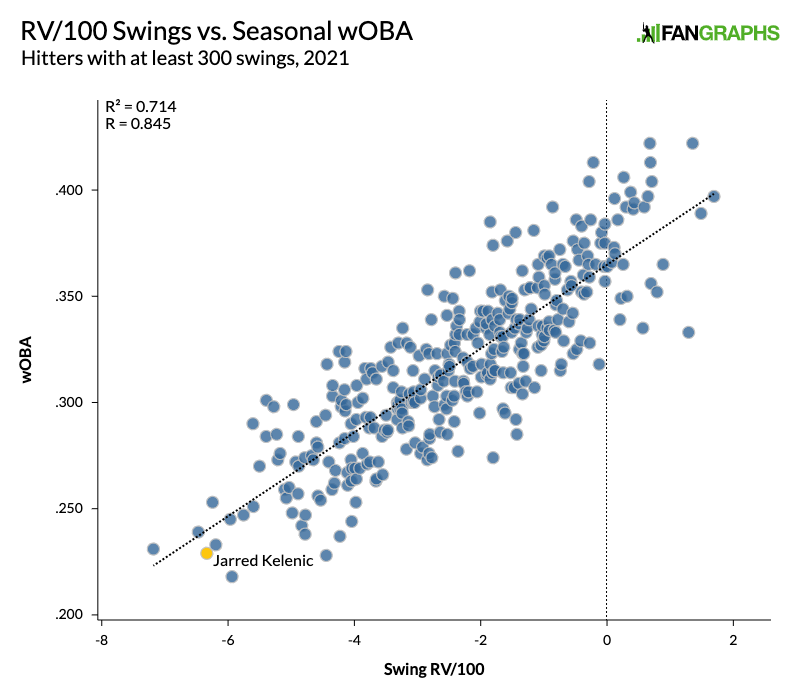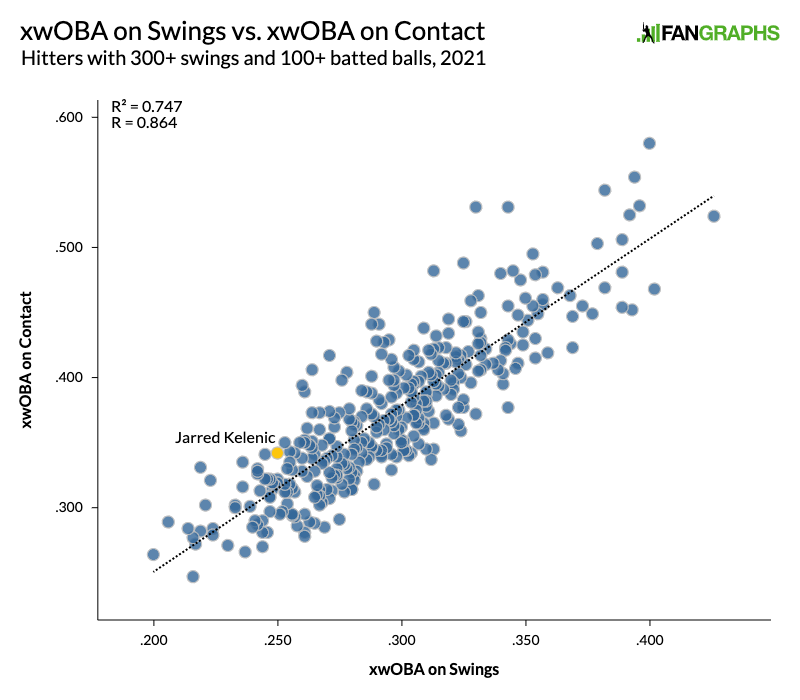Jarred Kelenic Keeps Coming Up Empty
In the days leading up to the trade deadline, Jarred Kelenic earned himself a mention in Jay Jaffe’s corner outfield replacement-level killers, a series that analyzes the players who are dragging down contending teams. The idea is to identify positions of need for potential trades to come, but Kelenic’s struggles in the majors weren’t going to force the team to make a deal. Instead, as Jay put it, “this should probably be a sink-or-swim situation unless he’s totally overwhelmed.”
Kelenic has already been in the spotlight because of the Mariners gaming his service time; his performance since his promotion has put him back in it. He got the call on May 13, but simply didn’t hit: In his first 23 games over a total of 92 plate appearances, he slashed .096/.185/.193. He collected just eight hits total and had come up empty in his last 44 plate appearances when the Mariners optioned him back to Triple-A in early June.
After a successful stint at Tacoma — a 137 wRC+ — Kelenic was brought back to Seattle. This time around, the results have been a bit better, but they’re still ugly overall, as he’s gone from a 10 wRC+ in that first stint to a .181/.263/.315 line and 65 wRC+ since his second promotion. Through Tuesday’s action, he’s up to a 45 wRC+ and -1.1 WAR in 64 games:
| ML Stint | PA | AVG | OBP | SLG | BB% | K% | wOBA | wRC+ |
|---|---|---|---|---|---|---|---|---|
| First | 92 | .096 | .185 | .193 | 8.7% | 28.3% | .177 | 10 |
| Second | 167 | .181 | .263 | .315 | 9.6% | 30.5% | .258 | 65 |
Even with the improved numbers since his return from Triple-A, Kelenic is still running the 11th-lowest wRC+ among qualified hitters in that time. He’s still not hitting well. But while there may not be one answer for why he is struggling, I believe that there’s a huge plate discipline problem that isn’t entirely captured in the walk and strikeout rates alone.
In today’s game, it is possible, though admittedly difficult, to succeed with a strikeout rate approaching 30%, but to compensate, you need to hit for power. There are 10 qualified hitters with a strikeout rate north of 30% and who have an ISO better than league-average, with seven of them boasting a mark at least 30% better. Kelenic has a .121 ISO so far, which ranks almost 30% below average (71 ISO+). His .131 xISO doesn’t suggest that he’s been unlucky in this regard, either. He just hasn’t made high-quality contact. (It is worth noting that he has at least average power, earning a 60 for raw and a 50 for in-game in our preseason Mariners prospect list.)
Without the power, the strikeout rate sticks out like a sore thumb, and there aren’t enough walks to compensate. That’s not the end of the story, though. For Kelenic, it’s less about the top-line numbers and more about the process. The difference between his in- and out-of-zone swing rates isn’t good, but it isn’t egregious either. His contact rates are all below-average, but not quite Patrick Wisdom levels. But there is a huge underlying problem, one that ties together the lack of the power and the plethora of strikeouts: When Kelenic swings, he does no damage. He’s one of the worst hitters in baseball when he swings. If the pitcher gets him to swing, they’ve won.
In fairness to Kelenic, when pitchers get hitters to swing, they generally win; hitters have been worth about 2.5 runs below-average per 100 swings. That makes intuitive sense when you think about it. While hitters can only do the most damage when swinging, they also make so many outs, whether in the field or with a strikeout, that pitchers benefit when a hitter chooses to take a hack. The potential reward of a swing is certainly quite high, but the cost is much higher.
Kelenic takes this to an extreme. When he swings, there’s almost no reward: He has been worth -6.3 runs per 100 swings this season, the third-worst mark in baseball among hitters with at least 300 hacks. Being able to succeed while swinging is one of the most important factors in terms of total production. There’s a very high correlation — an R² of 0.714 — between the value generated when hitters swing and their seasonal wOBA:

This isn’t some groundbreaking study: Hitters who do more damage when they swing will have higher wOBAs. But what we see here is something slightly beyond what we see in wOBA. Since wOBA is dependent only on the plate appearance-ending pitches, this shows us something more about the process. If you’re not doing damage when you swing, you’re going to struggle to be a productive big league player. That’s what’s happening with Kelenic.
I compared this to the explanatory power of takes on wOBA. The correlation between take run value per 100 pitches and wOBA was much lower, with an R2 of 0.178. Again, this makes sense, as there’s only one positive outcome that can result from taking a pitch: a walk. And while each incremental ball in an at-bat increases the average hitter’s wOBA, it’s the final pitch — the one on which the hitter swings in all situations except walks and looking strikeouts — that creates the outcome. Better hitters are inherently better because when they choose to swing, they do the most damage.
As mentioned, Kelenic has been worth -6.3 runs per 100 swings. His +1.9 runs per 100 takes ranks slightly better but still isn’t sterling; it’s in the 22nd percentile. That latter figure is probably not as much of a concern as the former. If he starts hitting the cover off of the ball, he’ll likely walk more as pitchers begin to nibble. The walks will be more frequent, and thus the takes will be more valuable.
Still, it’s not that his quality of contact is that bad; he has a .342 xwOBA, which is worse than the major league average (.363) but not as bad as his overall numbers would suggest. But if you look at his expected wOBA per swing rather than by batted ball, it becomes clear why he’s struggled so much this season. Kelenic ranks in the 32nd percentile in xwOBA on contact but in the 11th percentile in xwOBA on swings.

Unsurprisingly, there’s a strong relationship between these two metrics. What’s important here is the residual; as you can see, Kelenic has a better xwOBA on contact than would be expected given his xwOBA on swings. His residual ranks in the 84th percentile, suggesting once again that poor swing decisions are the culprit dragging down his overall numbers. That’s not to say that better discipline will fix all of his problems. I’m still concerned by his quality of contact, given that it, too, is below league-average. But when you combine that with even worse plate discipline, you get yourself a really tough start to your big league career.
It’s still very likely that Kelenic will be a successful big league player; concluding otherwise based on 259 plate appearances at the start of his career is silly. But given the major bumps he’s run into so far, it might be time to ask what changes need to be made to tap fully into the superstar prospect status. A good start would be by doing more damage when he swings, something that could begin by simply taking more productive swings in general.
Devan Fink is a Contributor at FanGraphs. You can follow him on Twitter @DevanFink.

I think he’s still going to be really good, but I’m also really surprised how poor his defensive grades look. Is it still small sample size? I know defense can be hard to quantify, but he’s grading really bad in both CF and RF, and that’s…alarming? Is this among one of the biggest rookie flops in recent memory? At least for a highly touted one?
For what its worth, Statcast has him as an average defender and even plus in CF.
https://baseballsavant.mlb.com/savant-player/jarred-kelenic-672284?stats=statcast-r-fielding-mlb
Keep in mind that Statcast does not do a great job with the outfield. In the past it didn’t even include throwing and it still might not. And if you look at what is really dragging Kelenic down in UZR it’s his arm.
Statcast is awesome in the infield but for the outfield it’s more directly comparable to range.
I wonder if the AAA West (previously PCL) numbers shouldn’t be looked at a little skeptically. Kieboom, Adell, Kelenic…three examples don’t necessarily prove anything, but maybe the berserk numbers from the west aren’t truly reflective of capability. All three have serious, serious strikeout issues that did not show up in the minors.
I guess you could include Cal Raleigh in this group as well, so far.
Do they have humidors over there?
Jo Adell has shown real improvement and signs of life this year. The PCL numbers are absolutely silly and probably can either be dismissed or heavily heavily weighted in projections but 2021 Jo Adell looks like a major leaguer—and possibly on a path toward a really good one—while 2020 Adell looked like Kelenic does now.
Sorry, could you point to where Jo Adell has looked like a major leaguer? I get that he’s better than last year but the numbers I’m seeing don’t exactly paint a picture of a guy on the path to really good. He seems to hit the ball softly if he hits it at all. Maybe there’s something that needs to be seen but the numbers don’t paint quite as rosy a picture.
Wasn’t the PCL always considered a pro-offense league? Vegas was definitely always a launching pad, and as I recall ABQ was a big offense park too. Lots of hot, dry ballparks at high elevation.
This is true. And while I’ve only loosely followed it myself, I believe that reports are saying it’s gotten even worse the last few years with ball changes. The sentiment now, at least, is closer to the league as a whole being a launchpad as opposed to merely hitter-friendly.
I would say Adell was always high risk based on contact issues in and before AAA. He still has time to turn it around. but it shouldn’t be surprising if he doesn’t. Kelenic’s issue is just weird as he hasn’t had contact issues or power issues before, and then to struggle as long as he has. Kyle Tucker and Bregman had rough starts in majors as well, but that was only the 1st 70-100 plate appearances.
His defensive numbers in CF, per Clay Davenport, were terrible. If anything his performance in CF has been better than expected…it’s in left field that he’s been really bad.